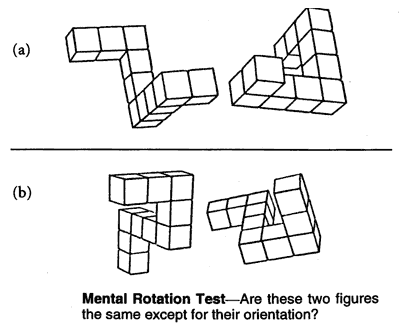Mental rotation tasks
From Psy3242
Contents |
Overview
Mental rotation tasks involve a person's ability to see a starting 2D or 3D object and to mentally rotate the object into a different position. These tasks also gauge a person's capacity to distinguish how the next object in a sequence is related to the original, starting object.

In order to assess competency on a mental rotation task, a participant is presented with a set number of pairs of objects. The second object in the pair is either a rotated version of the original or is a mirror image (also called an enantiomorph). If the object is rotated rather than mirrored, it is usually rotated a certain number of degrees, such as multiples of 60. Once the task has begun, the participant's ability to distinguish between mirrored pairs and non-mirrored pairs (and subsequent response time) is recorded.[1]
When performing a mental rotation task, a person progresses through five cognitive stages. The first stage is to imagine the object and the second is to rotate the object mentally until it is at a point where the person can compare it to the original object. The person actually makes the comparison in the third stage and then decides in the fourth stage whether the objects are the same. In the final stage, the participant reports his conclusion to the investigator.[2]
Research on Mental Rotation
The amount that the second object is rotated was found by Roger Shepard and Jacqueline Metzler to be related linearly to the amount of time it took a person to determine if the objects were the same. The farther the second object was rotated, the longer it took for the person to make a decision, regardless of whether the object was 2D or 3D. Even with 3-D objects, the axis the object was rotated was insubstantial compared to the effect of the degree of rotation. Also, participants who have been allowed to practice mental rotation before performing the task have notably shorter response times [3].
Another study by Parsons indicates that there may be multiple systems in the brain that are responsible for making mental rotation possible. When presented with images of the body to rotate (such as hands and heads) as opposed to the usual 3D blocks, participants had longer response times when they were asked to rotate the images in directions that certain parts of the body would not usually be able to turn. A result like this suggests that more than just visual pathways may be used during processing and analysis of mental images[4].
Mental Rotation and Parts of the Brain
The actual process of mental rotation takes place in the right cerebral hemisphere, an area also involved with perception.[5]
Psychologists have recently been able to use functional magnetic resonance imaging (fMRI) technology to see what parts of the brain are activated during mental rotation tasks. These scans of the brain have shown activity in the frontal cortex, Brodmann's areas 7A and 7B, and the middle frontal gyrus [6]. Also, according to PET research, the parietal lobe seems to be involved in the performance of mental rotation tasks. Patients with damage in the right hemisphere tend to have more trouble and slower response times when engaging in these tasks (Stirling 175). A result like this is in keeping with the idea that the right hemisphere is more involved in spatially-oriented tasks and more likely to cause this kind of difficulty when damaged.
According to Stirling (49), boys tend to be better at mental rotation tasks than girls which could be from experience but, as this tends to be an early developmental characteristic, it could also be due to differential brain organization.
Resources
Mental Imagery > Mental Rotation (Stanford Encyclopedia of Philosophy)
Stirling, John. Introducing Neuropsychology. New York: Psychology Press, 2004.
